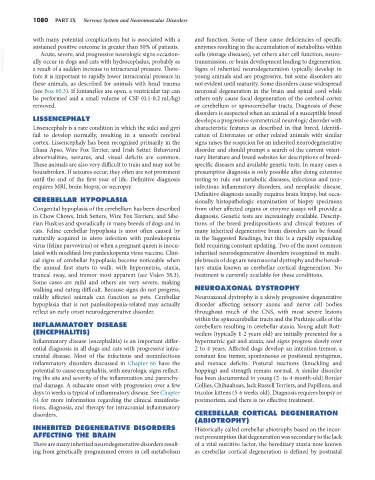Page 1108 - Small Animal Internal Medicine, 6th Edition
P. 1108
1080 PART IX Nervous System and Neuromuscular Disorders
with many potential complications but is associated with a and function. Some of these cause deficiencies of specific
sustained positive outcome in greater than 50% of patients. enzymes resulting in the accumulation of metabolites within
VetBooks.ir ally occur in dogs and cats with hydrocephalus, probably as cells (storage diseases), yet others alter cell function, neuro-
Acute, severe, and progressive neurologic signs occasion-
transmission, or brain development leading to degeneration.
a result of a sudden increase in intracranial pressure. There-
young animals and are progressive, but some disorders are
fore it is important to rapidly lower intracranial pressure in Signs of inherited neurodegeneration typically develop in
these animals, as described for animals with head trauma not evident until maturity. Some disorders cause widespread
(see Box 60.3). If fontanelles are open, a ventricular tap can neuronal degeneration in the brain and spinal cord while
be performed and a small volume of CSF (0.1-0.2 mL/kg) others only cause focal degeneration of the cerebral cortex
removed. or cerebellum or spinocerebellar tracts. Diagnosis of these
disorders is suspected when an animal of a susceptible breed
LISSENCEPHALY develops a progressive symmetrical neurologic disorder with
Lissencephaly is a rare condition in which the sulci and gyri characteristic features as described in that breed. Identifi-
fail to develop normally, resulting in a smooth cerebral cation of littermates or other related animals with similar
cortex. Lissencephaly has been recognized primarily in the signs raises the suspicion for an inherited neurodegenerative
Lhasa Apso, Wire Fox Terrier, and Irish Setter. Behavioral disorder and should prompt a search of the current veteri-
abnormalities, seizures, and visual deficits are common. nary literature and breed websites for descriptions of breed-
These animals are also very difficult to train and may not be specific diseases and available genetic tests. In many cases a
housebroken. If seizures occur, they often are not prominent presumptive diagnosis is only possible after doing extensive
until the end of the first year of life. Definitive diagnosis testing to rule out metabolic diseases, infectious and non-
requires MRI, brain biopsy, or necropsy. infectious inflammatory disorders, and neoplastic disease.
Definitive diagnosis usually requires brain biopsy, but occa-
CEREBELLAR HYPOPLASIA sionally histopathologic examination of biopsy specimens
Congenital hypoplasia of the cerebellum has been described from other affected organs or enzyme assays will provide a
in Chow Chows, Irish Setters, Wire Fox Terriers, and Sibe- diagnosis. Genetic tests are increasingly available. Descrip-
rian Huskies and sporadically in many breeds of dogs and in tions of the breed predispositions and clinical features of
cats. Feline cerebellar hypoplasia is most often caused by many inherited degenerative brain disorders can be found
naturally acquired in utero infection with panleukopenia in the Suggested Readings, but this is a rapidly expanding
virus (feline parvovirus) or when a pregnant queen is inocu- field requiring constant updating. Two of the most common
lated with modified-live panleukopenia virus vaccine. Clini- inherited neurodegenerative disorders recognized in multi-
cal signs of cerebellar hypoplasia become noticeable when ple breeds of dogs are neuroaxonal dystrophy and the heredi-
the animal first starts to walk, with hypermetria, ataxia, tary ataxia known as cerebellar cortical degeneration. No
truncal sway, and tremor most apparent (see Video 58.3). treatment is currently available for these conditions.
Some cases are mild and others are very severe, making
walking and eating difficult. Because signs do not progress, NEUROAXONAL DYSTROPHY
mildly affected animals can function as pets. Cerebellar Neuroaxonal dystrophy is a slowly progressive degenerative
hypoplasia that is not panleukopenia-related may actually disorder affecting sensory axons and nerve cell bodies
reflect an early onset neurodegenerative disorder. throughout much of the CNS, with most severe lesions
within the spinocerebellar tracts and the Purkinje cells of the
INFLAMMATORY DISEASE cerebellum resulting in cerebellar ataxia. Young adult Rott-
(ENCEPHALITIS) weilers (typically 1-2 years old) are initially presented for a
Inflammatory disease (encephalitis) is an important differ- hypermetric gait and ataxia, and signs progress slowly over
ential diagnosis in all dogs and cats with progressive intra- 2 to 4 years. Affected dogs develop an intention tremor, a
cranial disease. Most of the infectious and noninfectious constant fine tremor, spontaneous or positional nystagmus,
inflammatory disorders discussed in Chapter 66 have the and menace deficits. Postural reactions (knuckling and
potential to cause encephalitis, with neurologic signs reflect- hopping) and strength remain normal. A similar disorder
ing the site and severity of the inflammation and parenchy- has been documented in young (2- to 4-month-old) Border
mal damage. A subacute onset with progression over a few Collies, Chihuahuas, Jack Russell Terriers, and Papillons, and
days to weeks is typical of inflammatory disease. See Chapter tricolor kittens (5-6 weeks old). Diagnosis requires biopsy or
64 for more information regarding the clinical manifesta- postmortem, and there is no effective treatment.
tions, diagnosis, and therapy for intracranial inflammatory
disorders. CEREBELLAR CORTICAL DEGENERATION
(ABIOTROPHY)
INHERITED DEGENERATIVE DISORDERS Historically called cerebellar abiotrophy based on the incor-
AFFECTING THE BRAIN rect presumption that degeneration was secondary to the lack
There are many inherited neurodegenerative disorders result- of a vital nutritive factor, the hereditary ataxia now known
ing from genetically programmed errors in cell metabolism as cerebellar cortical degeneration is defined by postnatal

